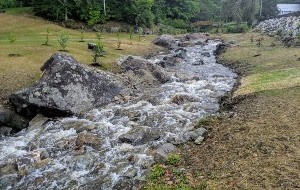MONTPELIER, Vt. – The Vermont Department of Environmental Conservation (DEC) recently released the Vermont Clean Water Initiative 2020 Performance Report. The Report summarizes how the state’s $194 million investment in water quality over the past five years is paying off by improving water quality in Vermont’s rivers, lakes, and wetlands.
While we can swim and fish in most of Vermont’s waters, some are impacted by water pollution. For example, excess phosphorus in Lake Champlain fuels potentially toxic cyanobacteria blooms in some parts of the lake. The State of Vermont funds clean water projects to prevent and reduce nutrient and sediment pollution and restore and protect water quality statewide.
Collectively, the state’s $194 million investment in water quality projects statewide has reduced pollution from over 90,000 acres of agricultural land, 200 miles of roadways, and 332 acres of pavement or other hard surfaces. In addition, 290 acres surrounding rivers, lakes, and wetlands were restored and over 1,200 acres were conserved to prevent and reduce pollution.
The Report also summarizes five years of progress implementing Lake Champlain’s twenty-year restoration plan. Since 2016, water quality projects implemented through state and federal funding programs and regulatory programs have prevented 62,000 pounds of phosphorus pollution from entering Lake Champlain. This represents 13 percent of the required reduction for the lake to meet Vermont Water Quality Standards.
“We’ve made significant progress over the past five years in Vermont. Since 2016, the State of Vermont has ramped up funding and regulatory programs and we anticipate results will continue to increase considerably,” said Natural Resources Secretary Julie Moore. “These early results are very encouraging. As a state, we need to continue to invest in Lake Champlain and other water bodies to ensure a full recovery in the coming years and decades.”
Projects to improve lakes, rivers, and wetlands have economic, environmental, and social benefits. The influx of state funding to develop and carry out projects bolsters the local economy by increasing work opportunities for local organizations. Restoring streams and wetlands improves wildlife habitat, strengthens biodiversity, and protects towns against flooding. Healthy streams and lakes have been essential during the pandemic, with many Vermonters turning to outdoor activities, such as fishing and paddling, for socially distant recreation.
Learn more about water quality in Vermont using two interactive tools, the Clean Water Project Explorer and the Clean Water Interactive Dashboard. The Department of Environmental Conservation will hold a virtual event on Monday, February 8, 2021 from 12:00 to 1:00 pm to present the Performance Report and its companion online tools as part of the Clean Water Lecture Series. To join, please pre-register.


Before and after photos of the Cold Spring Brook Park dam removal in the Town of Weston, which restored over 350 feet of stream to a more natural condition. Project funded by a Department of Environmental Conservation Clean Water Initiative Program grant. (Source: Weston Community Association)
